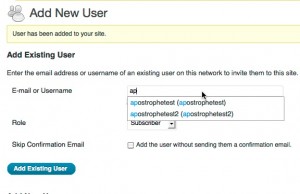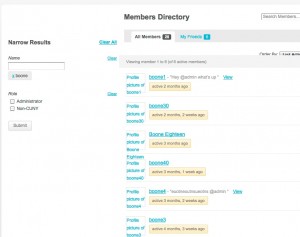Today I devoted an unusually large amount of time doing free user support for BuddyPress and WordPress (in IRC, over email, through some Trac tickets, and on WordPress StackExchange, the latter of which I’ve been experimenting with for the first time, and I find pretty cool). I say “unusually large” because while I used to do a lot of this sort of thing, it now falls to the bottom of my list of priorities – I do paid work, and when I’m not doing that I do free software development, and when I’m not doing that I try to get the hell away from my computer. As one of the leaders of the BuddyPress project, I usually justify this balance to myself by saying: There are lots of people who can provide user support for this software as well as I can, but there are few who can do productive development for it like I can, so my time is better spent developing. Generally, I think this is a pretty good argument. But I’m glad that days like today come along occasionally, because they remind me of some basic things about the nature of the community around a piece of free software that you can forget when your head is buried too deep in the codebase.
As an aside, I should note that I use the word ‘community’ in a measured way. The word is often overapplied, as if calling a bunch of people working on similar things “the WordPress community” or “the Digital Humanities community” or “the CUNY community” will, in a feat of performative metamorphosis (like how the Queen’s saying “I dub thee Sir Boone” would ipso facto make me a knight), bring into being the thing it purports to describe. Terminological misgivings to one side, there is an undeniable sense in which the work that we do – and by “we” here I mean specifically free software developers, though the point is quite a bit more general than that – is done in a community, or at least (more formally) a network, insofar as those who work on a common piece of free software never really work in isolation from one another. The development process that underlies these software projects depends on the existence of feedback loops, from the end user to the administrator of the installation to the community leaders to the developers themselves, in the form of bug reports, software patches, feature suggestions, support requests, blog posts, and so on.
These feedback loops are not unique to free software development; they’re not even unique to software. But in free software circles the loops are perhaps uniquely malleable, and the distinctions between user and developer uniquely permeable. Each user is a potential contributor, be it through code or advocacy. But the potential is not realized automatically. It’s obvious enough that users who hate using the software and developers whose patches are ignored will never become part of the community. More interesting is the case where a newbie approaches the community with enthusiasm and skill, but where their offerings are not nurtured and so never become real contributions.
I think this happens more than we would care to admit, and I am happy to take my share of the blame. As a developer, I become emotionally attached to the project, and as a result I sometimes interpret criticism as a personal attack. The parts of development that are least exciting – hunting down and fixing the obscure bugs that affect only a small number of users but, for those users, are ruinous – these make me defensive and sometimes angry, as they take my attention away from the more generative work I’d rather be doing. I value my time so highly that I occasionally get annoyed when someone requests some of that time to answer a “simple” question. In each instance, my attitude as a developer and leader of the project could have the effect of chilling what might otherwise have been a fruitful engagement.
Taking the time to do some “support” is the ideal way to fight these tendencies. People ask questions about the software, contribute patches, suggest improvements, etc, because they like the software and want to use it. These people are friends of the project, and should not be treated as enemies. Taking the time to work directly with users is a way of closing the feedback circuit, of sowing the seeds of future collaboration and contribution. If one out of five people recommends the software to someone else, and one out of a hundred contributes back to the software in the form of documentation or code or advocacy, that’s fruitful enough to make the engagement worthwhile.


